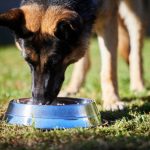1. The Basics of Dog Nutrition
Understanding what goes into your dogs diet is essential for their overall health and well-being. Just like humans, dogs need a balanced diet that includes essential nutrients to thrive. These nutrients include proteins, fats, carbohydrates, vitamins, and minerals. Each plays a crucial role in keeping your pup healthy and full of energy.
Proteins: The Building Blocks of Health
Protein is one of the most important nutrients in your dog’s diet. It helps build and repair tissues, supports immune function, and maintains a healthy coat and skin. Dogs get protein from sources like meat, fish, eggs, and plant-based options such as lentils and peas.
Common Protein Sources for Dogs
| Protein Source | Benefits |
|---|---|
| Chicken | High in lean protein and easy to digest |
| Beef | Rich in amino acids and iron |
| Fish | Packed with omega-3 fatty acids for skin and coat health |
| Eggs | A great source of complete protein and essential nutrients |
| Lentils & Peas | A plant-based protein option with fiber benefits |
Fats: Essential for Energy and Health
Fats provide a concentrated source of energy for dogs. They also help absorb fat-soluble vitamins (A, D, E, and K) and contribute to a shiny coat and healthy skin. Good sources of fat include fish oil, chicken fat, flaxseed, and certain vegetable oils.
Carbohydrates: Providing Necessary Fuel
While dogs don’t require as many carbohydrates as humans do, carbs still play an important role in providing energy. Whole grains like brown rice, sweet potatoes, and vegetables are excellent sources of fiber and essential nutrients.
Vitamins and Minerals: Supporting Overall Well-Being
Your dog needs a variety of vitamins and minerals to support their immune system, bone health, metabolism, and organ function. These come from high-quality commercial dog food or fresh ingredients like fruits and vegetables.
Key Vitamins & Their Benefits
| Vitamin | Main Benefits | Main Sources |
|---|---|---|
| A | Supports vision & immune system | Liver, carrots, spinach |
| D | Aids calcium absorption & bone health | Fish oil, egg yolks |
| E | Powers cell function & skin health | Nuts, leafy greens, vegetable oils |
| K | Aids blood clotting & healing wounds | Kale, liver, dairy products |
| B-complex (B1-B12) | Energizes metabolism & brain function | Poultry, eggs, whole grains |
| C | Powers immune defense & antioxidant properties | Citrus fruits, bell peppers (though dogs produce vitamin C naturally) |
The Importance of Balanced Nutrition
A well-balanced diet ensures your dog stays active, maintains a healthy weight, and avoids common nutritional deficiencies. Whether you’re feeding kibble, raw food, or homemade meals, making sure they receive the right mix of proteins, fats, carbohydrates, vitamins, and minerals is key to their long-term health.
2. Choosing the Right Dog Food
Picking the right food for your dog can feel overwhelming with so many options available. Each type of dog food has its own benefits and potential drawbacks. Understanding these choices can help you make the best decision for your pet’s health and lifestyle.
Kibble (Dry Food)
Kibble is one of the most popular choices for dog owners due to its convenience and long shelf life. It is typically more affordable than other types of dog food and can help maintain dental health by reducing plaque buildup.
Pros:
- Convenient and easy to store
- More affordable than wet or raw diets
- May help with dental health
Cons:
- Can contain fillers and artificial ingredients
- Less moisture content, which may not be ideal for dogs needing extra hydration
Wet Food (Canned Food)
Wet food has a higher moisture content, making it a great option for dogs that need extra hydration. It is often more palatable for picky eaters but can be more expensive and less convenient to store once opened.
Pros:
- Higher moisture content, which supports hydration
- Softer texture, good for older dogs or those with dental issues
- Often more appealing in taste compared to dry food
Cons:
- Shorter shelf life once opened
- Tends to be more expensive than kibble
- Can contribute to dental issues if not paired with proper oral care
Raw Diets
A raw diet consists of uncooked meat, bones, fruits, and vegetables. Some pet owners prefer this type of diet because it mimics what dogs would eat in the wild. However, it requires careful planning to ensure nutritional balance and safety.
Pros:
- Mimics a natural diet with whole foods
- May improve coat quality and energy levels
- No artificial additives or preservatives
Cons:
- Requires careful handling to prevent bacterial contamination
- Can be expensive and time-consuming to prepare
- Difficult to ensure proper nutrient balance without supplementation
Home-Cooked Meals
Some pet owners prefer to prepare meals at home using fresh ingredients. While this allows complete control over what goes into your dogs diet, it requires thorough research to ensure all nutritional needs are met.
Pros:
- Total control over ingredient quality
- No artificial additives or preservatives
- Can be tailored to specific dietary needs or allergies
Cons:
- Time-consuming to prepare regularly
- Difficult to achieve a balanced diet without expert guidance
- Requires additional supplements in many cases
Comparison of Dog Food Types
| Food Type | Main Benefits | Main Drawbacks |
|---|---|---|
| Kibble (Dry Food) | Convenient, affordable, helps with dental health | Lower moisture content, may contain fillers |
| Wet Food (Canned) | High moisture content, softer texture, better taste for picky eaters | Spoils quickly after opening, more expensive than kibble |
| Raw Diets | Mimics natural diet, improves coat and energy levels, no additives | Bacterial risks, expensive, requires careful meal planning |
| Home-Cooked Meals | Total control over ingredients, customizable for special diets | Time-consuming, difficult to balance nutrients properly |
Selecting the Best Option for Your Dog
The best dog food choice depends on your pet’s age, activity level, health conditions, and personal preferences. If youre unsure which option is best for your dog, consult with your veterinarian. A well-balanced diet plays a crucial role in keeping your furry friend happy and healthy.
No matter what type of food you choose, always look for high-quality ingredients and avoid artificial additives whenever possible. A well-fed dog is a happy and energetic companion!

3. Reading Dog Food Labels
Choosing the right dog food can be overwhelming with all the options available. Understanding how to read dog food labels is essential to ensure your furry friend gets the best nutrition possible. Let’s break down three key aspects of dog food labels: ingredient lists, guaranteed analysis, and nutritional adequacy statements.
How to Interpret Ingredient Lists
The ingredient list on a dog food label tells you what’s in the food, listed in descending order by weight. Here are some important things to look for:
- High-Quality Protein Sources: Look for named meat sources like “chicken,” “beef,” or “salmon” as the first ingredient.
- Avoid Fillers: Ingredients like corn, wheat, and soy are often used as fillers and may not provide essential nutrients.
- Whole Foods Are Better: Fruits, vegetables, and whole grains provide natural vitamins and minerals.
- Beware of By-Products: Some by-products can be nutritious, but avoid vague terms like “animal by-product” without specifying the source.
Understanding Guaranteed Analysis
The guaranteed analysis section provides a breakdown of key nutrients in the food. It typically includes percentages of protein, fat, fiber, and moisture. Here’s a basic guide:
| Nutrient | What It Means |
|---|---|
| Crude Protein | Essential for muscle development and overall health; look for at least 18-22% for adult dogs. |
| Crude Fat | A good energy source; should be around 8-15% depending on your dogs needs. |
| Crude Fiber | Aids digestion; typically 2-5% is ideal for most dogs. |
| Moisture | The water content in the food; usually around 10% for dry kibble. |
Nutritional Adequacy Statements
This statement tells you if the food meets AAFCO (Association of American Feed Control Officials) standards for complete and balanced nutrition. Look for phrases like:
- “Complete and balanced nutrition for all life stages” – Suitable for puppies, adults, and seniors.
- “Formulated to meet the nutritional levels established by AAFCO” – Ensures it meets minimum standards.
- “For intermittent or supplemental feeding only” – Not suitable as a primary diet.
Final Tip: Comparing Different Brands
If you’re comparing different brands, make sure to check both the ingredients and the guaranteed analysis to find the best option for your dog’s specific needs. Always consult your vet if you’re unsure about what diet is best for your pet!
4. Common Dietary Issues and Food Allergies
Just like humans, dogs can experience food allergies, sensitivities, and digestive issues. Recognizing the signs early can help you adjust your dogs diet to keep them happy and healthy.
Identifying Food Allergies and Sensitivities
Food allergies in dogs occur when their immune system overreacts to a specific ingredient. Sensitivities, on the other hand, may not involve an immune response but can still cause discomfort. Here are some common signs of food-related issues:
| Type of Issue | Common Symptoms |
|---|---|
| Food Allergy | Itchy skin, excessive licking, ear infections, red or inflamed skin, chronic diarrhea |
| Food Sensitivity | Bloating, gas, intermittent diarrhea, vomiting, changes in appetite |
| Digestive Issues | Frequent diarrhea, constipation, excessive gas, stomach gurgling |
Common Food Allergens for Dogs
Certain ingredients are more likely to trigger allergies in dogs. If your pup is experiencing symptoms, consider whether their diet includes any of these common allergens:
- Dairy products
- Beef
- Chicken
- Lamb
- Soy
- Corn
- Eggs
- Wheat and gluten
How to Adjust Your Dog’s Diet
1. Try an Elimination Diet
If you suspect your dog has a food allergy or sensitivity, an elimination diet can help identify the culprit. This involves feeding your dog a limited-ingredient diet with novel proteins (such as venison or duck) and avoiding common allergens for at least 8–12 weeks.
2. Opt for Hypoallergenic Dog Food
If your dog has known allergies, hypoallergenic diets that contain hydrolyzed proteins (broken down into smaller components) can reduce reactions and improve digestion.
3. Introduce New Foods Gradually
Abrupt changes in diet can upset your dogs stomach. When switching foods, do so gradually over 7–10 days by mixing increasing amounts of the new food with the old one.
4. Consult Your Veterinarian
If symptoms persist despite dietary changes, consult your vet for further testing and recommendations. They may suggest allergy testing or prescription diets tailored to your dog’s needs.
A well-balanced diet plays a crucial role in keeping your furry friend healthy. By identifying and addressing dietary issues early on, you can ensure your dog enjoys a happy and comfortable life.
5. Human Foods: Safe or Toxic?
As a pet owner, it’s natural to want to share your favorite snacks with your furry friend. However, not all human foods are safe for dogs. Some can be enjoyed in moderation, while others should be avoided at all costs. Below is a guide to help you determine what’s safe and what’s dangerous for your pup.
Safe Foods for Dogs
These foods are generally safe for dogs and can even provide nutritional benefits:
| Food | Benefits |
|---|---|
| Carrots | Great for dental health and rich in vitamins. |
| Blueberries | Packed with antioxidants that support the immune system. |
| Peanut Butter (Unsalted & Xylitol-Free) | A tasty treat with healthy fats and protein. |
| Cooked Chicken | A lean source of protein that supports muscle growth. |
| Pumpkin (Plain, Not Pie Filling) | Aids digestion and helps with an upset stomach. |
| Cucumber | A low-calorie snack that helps keep dogs hydrated. |
Toxic Foods to Avoid
Certain human foods can be extremely harmful or even fatal to dogs. Never feed these items to your pup:
| Food | Dangers |
|---|---|
| Chocolate | Toxic due to theobromine, which affects the heart and nervous system. |
| Grapes & Raisins | Can cause kidney failure, even in small amounts. |
| Onions & Garlic | Dangerous to red blood cells, leading to anemia. |
| Xylitol (Artificial Sweetener) | Lowers blood sugar rapidly and can cause liver failure. |
| Avocado | Contains persin, which is toxic to dogs in large amounts. |
| Caffeine (Coffee, Tea, Energy Drinks) | Affects the heart and nervous system, potentially causing seizures. |
| Bones from Cooked Meat | Brittle bones can splinter and cause choking or digestive injuries. |
How to Keep Your Dog Safe?
- Read Labels: Always check ingredient lists before sharing food with your dog.
- Avoid Table Scraps: Many human meals contain hidden dangers like salt, spices, or harmful ingredients.
- Create a Dog-Friendly Diet: Stick to vet-approved treats and meals specifically made for canine health.
- If in Doubt, Ask a Vet: When unsure about a certain food, consult your veterinarian before feeding it to your dog.
The Bottom Line on Human Foods for Dogs
Your dog’s health depends on a balanced diet and avoiding harmful foods. By knowing which human foods are safe and which ones are toxic, you can ensure your furry companion stays happy and healthy!
6. Feeding Guidelines for Different Life Stages
Nutritional needs vary for puppies, adult dogs, and senior dogs. Each life stage requires a different balance of nutrients to support growth, maintenance, and overall health. Understanding these needs will help you provide the best diet for your furry friend.
Puppy Nutrition
Puppies grow rapidly and need a diet rich in protein, fat, and essential vitamins to support their development. Look for high-quality puppy food that meets AAFCO (Association of American Feed Control Officials) standards.
Key Nutritional Needs:
- High protein content (22-32%) to support muscle growth
- Healthy fats (8-20%) for energy and brain development
- DHA (an omega-3 fatty acid) for cognitive function
- Calcium and phosphorus for strong bones
Feeding Schedule:
| Age | Meals per Day |
|---|---|
| 8-12 weeks | 4 meals |
| 3-6 months | 3 meals |
| 6-12 months | 2 meals |
Adult Dog Nutrition
Once your dog reaches adulthood, their diet should focus on maintaining a healthy weight and providing sustained energy. The right balance of proteins, fats, and carbohydrates is crucial.
Key Nutritional Needs:
- Moderate protein (18-25%) for muscle maintenance
- Healthy fats (5-15%) to maintain coat health
- Fiber for digestive health
- Balanced vitamins and minerals to support immune function
Feeding Schedule:
Most adult dogs do well with two meals per day. Adjust portion sizes based on their activity level, breed, and metabolism.
Senior Dog Nutrition
Aging dogs have slower metabolisms and may require special diets to maintain joint health and prevent obesity. Many senior dog foods contain added supplements like glucosamine and chondroitin.
Key Nutritional Needs:
- Lower calories to prevent weight gain
- Higher fiber for digestive health
- Joint-supporting supplements like glucosamine and omega-3s
- Easily digestible proteins for muscle maintenance
Feeding Schedule:
Seniors may benefit from smaller, more frequent meals to aid digestion. Monitor their weight and adjust portions accordingly.
Adjusting Diet Based on Your Dogs Needs
No two dogs are exactly alike. Factors such as breed, activity level, and health conditions play a role in dietary requirements. Regular check-ups with your veterinarian can help ensure your dog’s nutritional needs are met throughout their life stages.


